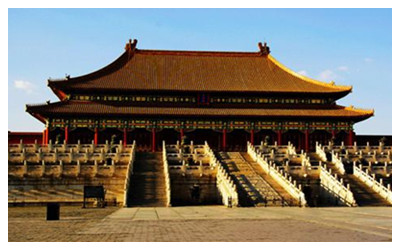
The use of
numbers in architecture is a reflection of the value pursuit of China's ancient architectural culture. The role of numbers in determining luck has a long history in Chinese Architectural culture.The numbers have rich connotations in Chinese traditional architectural culture, and each number also has its own special significance in Chinese architecture.
Ancient Chinese regarded odd numbers as being masculine and heaven,symbolizing auspiciousness, happiness, harmony and contentment, even numbers as being feminine and earth, meaning cold and ominous. Yin-yang is the two complementary forces that make up all aspects and phenomena of life. According to this idea, 6 and 9 were designated as representatives of even and odd numbers respectively to be used widely in ancient Chinese architecture.
Number "9"
In Fengshui, "Nine", is the largest single digit number scale and represents the mean "ultimate masculinity". In ancient China, It symbolized the supreme sovereignty of the emperor. For this reason, the number "nine" (or its multiples) was often employed in ancient palace structures and designs. A noticeable example is the number of studs on palace gates. The studs are usually arranged in nine rows of nine each, total eighty-one. The rooms number is also 9,999 in the Forbidden City.
The number "nine" was sometimes combined with "five" to represent imperial majesty. The great hall on Tiananmen Square is 9 bays wide by 5 bays deep.
The number "nine" is not only used on buildings. The New Year dinner for the imperial house was composed of 99 dishes. To celebrate the birthday of an emperor, the stage performances must comprise of 99 numbers as a sign of good luck and longevity.
Number "6"
The number "6" is pronounced "liu" in Mandarin Chinese, which sound byte is close to the sound byte for the Mandarin Chinese word which means "flowing, smooth", therefore the number 6 is considered very lucky, especially where it occurs in multiples. In Fengshui, the number 6 represents authority and power. And it is also usually used on buildings.
For example, in the Forbidden City of
Beijing, there are the East Sixth Palace and West Sixth Palace, which are the inner courts where the queens and concubines live. Most of these buildings use the better number "six" among even numbers.
Ordinary Chinese people like the "six" in the even number. The reason is that they think that the upper and lower four sides are the numbers of the "six in six luck". Hope for a harmonious symbiosis and praying for happiness. As a representative of residential architecture in Qixian County, Shanxi Province, the Qiao Family Courtyard is composed of six courtyards, and its purpose is to pray for the six-six good lucky of the Qiao family.

 The use of numbers in architecture is a reflection of the value pursuit of China's ancient architectural culture. The role of numbers in determining luck has a long history in Chinese Architectural culture.The numbers have rich connotations in Chinese traditional architectural culture, and each number also has its own special significance in Chinese architecture.
The use of numbers in architecture is a reflection of the value pursuit of China's ancient architectural culture. The role of numbers in determining luck has a long history in Chinese Architectural culture.The numbers have rich connotations in Chinese traditional architectural culture, and each number also has its own special significance in Chinese architecture. Ask Questions ?
Ask Questions ?